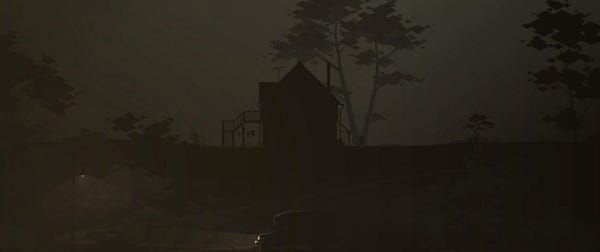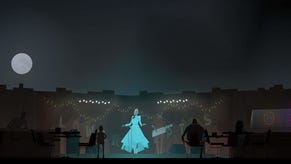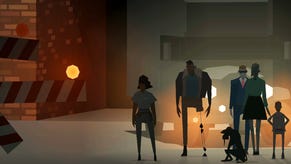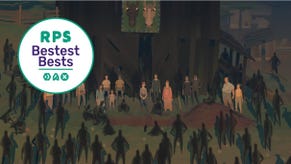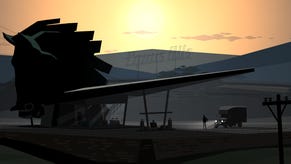Wot I Think: Kentucky Route Zero Act I
Empirical State of Mind
Kentucky Route Zero tells a story about an underground highway and you can experience that story by pointing at things and clicking on them. So is it a point and click adventure? Sort of. But it's also a weird and wonderful bluegrass ballad, a poem about play, and a showcase for intelligent writing and gorgeous art. Here's wot I think.
I had a dream about Kentucky Route Zero a couple of nights ago, which is an entirely appropriate reaction to its magical realist landscape and locations. In the dream, the dilapidated farmhouses and cut-away basements were stranded with seaweed and rotten fish, having been lost underwater for years. The sea that covered the state eventually retreated when the tide went out one day and never stopped going, whispering away over the horizon. I’d conflated its world with Gabriel Garcia Marquez’ Autumn of the Patriarch. That’s grand company to be in and the game sits comfortably there. Both works sashay around surrealism, in an emotionally and intellectually cohesive fashion.
Even if all you’ve seen is the trailer, you may have thought to yourself, ‘they don’t make ‘em like that anymore’. When I finished playing, I was left thinking that they never did. With The Walking Dead’s unexpected quality a recent memory, it’s fascinating to play another game that is essentially a point and click adventure of old, favouring drama rather than humour. But while Telltale’s game favours the melodrama of a grim horror serial, Kentucky is a more literary work. It’s one of the few games I’ve played recently that, were it a book, couldn’t rightly be placed in the genre section. It’s ‘Fiction’ and if the level of quality is maintained across all five Acts, it’s destined to be a modern classic.
There’s something of Another World and Flashback in the graphics, stylised 3D that conveys more varied tones in just a couple of scenes than most games attempt in their entirety. The issue of length will be a sticking point for some but rest assured there are several lengthy scenes and smaller events to discover on the roads that criss-cross this imaginary Kentucky. I’d be surprised if anyone could finish the first Act in less than an hour, even if they foolishly rushed it, and my own playthrough was at least three hours, although I did spend time just looking and listening. I’m planning to play again as well, not because I want to choose different dialogue options but because I want to explore every corner. I’ll also enjoy experiencing some of the breathtaking moments again, exactly as they were, because this really is a game of exquisite moments.
The walls of buildings fall away to allow a view inside, suddenly resembling Edward Hopper paintings, though of rural isolation and dilapidation rather than the more celebrated urban melancholia. Kentucky does maintain its fourth wall, although it brushes against it occasionally by means of its words and smaller visual details. The barrier between player and game flickers into view most notably whenever concepts of ‘play’ are mentioned or alluded to. Clicking the ground to move causes a small stake of light to shoot up and a horseshoe rattles around it. Is that game one of lead character Conway’s memories as well as a reminder that the player’s interaction is a playful act in itself? For all that it address inner nature - and this is soulful game if ever there was one – there are still minor puzzles to solve and we propel Conway toward solutions and targets.
Everything is beautiful and soaked in meaning, images and words that speak directly to the heart and mind. There’s a fair amount of text, both as conversation and description, with one location acted out as a text adventure, which pissed me off at first. When a game is so beautifully constructed, I want to see more of it, but then I realised that I wanted to read more of the game as well, and accepted that there was a reason I couldn’t see that particular interior as I fumbled my way through it. It’s a very reasonable game and one of the most proudly intellectual that I can remember.
Perhaps that’s an odd observation to make, but I think it’s important. I’m accustomed to games that have a point to make or an agenda driving their narrative, and that can be well and good, but it’s incredibly rare to feel such so comfortable in a designer’s ability to challenge and surprise with their own imaginative intelligence as well as references and quotes. When the game started, I immediately clicked on Conway’s dog, to test how interaction worked as much as out of any specific curiosity.
“An old dog in a straw hat.”
The words hang for a beat.
“Both have seen better days.”
I feel like I’m in capable hands when I read that. First of all, it’s awesome to be accompanied by a dog wearing a hat, but that small pause is a comedian winding up an audience and a small catch in the throat at the same time. Note that the dog's hat isn't silly in any way. If anything, it's dignified. There is a bleak humour in the game and while it's not quite delivered from the gallows, it is at least in their shadow. Mostly it’s just delightfully and consistently sorrowful and serious-minded, although with a jaunty crick in its step and a sense of wonder and fun in its environments and characters.
When the whole thing is complete, exploring its themes – memory, loss, love, travel? – should lead to exciting and lengthy conversations, but for now there’s a fragility. I don’t want to squeeze too hard because until the next part comes, and the one after, I worry that by looking too hard, I’ll botch my instinctive reaction, which is to just let it be. For now, at least. There’s one scene in which the camera pans toward a television, except it doesn’t, defying the scripted line of motion and discovering something else instead. It’s one of the most mind-tingling, heart-fluttering things I’ve seen for months, in any form of media.
It’s astounding how this one managed to creep up on me. I’d seen the trailer and there was something special in that but I’m staggered by how effective the mysteries and meanderings are. The story is mumbled, a shaggy dog story as told by hobo Umberto Eco, but there’s such a grace in the idiosyncrasies of the telling. In the first scene, a truck drove past in the background, one of several vehicles, and it was only later, when I switched to the top-down map and began to drive, that I questioned it. Kentucky doesn’t have a population beyond Conway’s immediate perception, I became convinced of that, but there had been signs of life and of other journeys right there for me to see.
The worst thing about this first Act is the frighteningly high bar it sets for the next four. The second has immediately shot to the top of my ‘most anticipated’ list and I’m grumpy about having to wait, although at least the episodic releases mean the game will stay at the front of my mind for the next twelve months.
Don’t take the trip for the puzzles because they are few and simple, take the trip because like all the best it’ll turn the horizon into an experience and surprise you every time the path twists or turns. Smart, thoughtful, sweet and incredibly well crafted – it’s the perfect game to play in the small hours of a lonely night. Be warned though; it’ll leave you hungry for unknown roads and longing for an invitation to the blues.
Kentucky Route Zero Act I is available now for $7, or you can buy it as a package with all five Acts delivered as they are released for $25.
